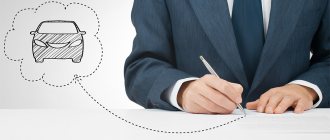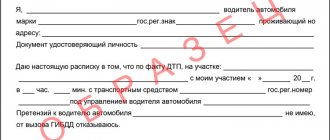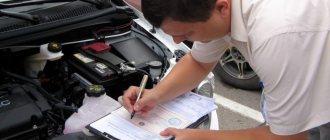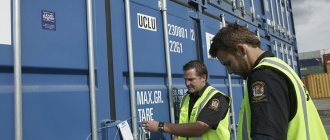What is it, what does it establish and how is it regulated?
Automotive technical examination in case of an accident is an expert examination of cars and other objects related to the accident, necessary to identify the circumstances and causes of the accident, as well as assess its consequences. It establishes the damage that was caused to cars as a result of the collision, as well as the culpability of the participants in the accident.
In addition, based on such examinations, statistics are collected that help make a forecast of the number and nature of possible accidents, as well as find ways to prevent the occurrence of emergency situations.
The examination is carried out based on the results of vehicle inspection and damage analysis .
An examination of the vehicle may also be necessary to identify any damage that may have caused the collision. Poor quality road repair work can also cause an emergency, so it is important to establish this fact as early as possible.
Why is an auto technical examination required after an accident?
To begin with, let’s define the essence of the concept of automotive technical expertise. This is an additional study of cars and other objects that were involved in road accidents. It is carried out to determine the culprit, as well as the damage and responsibility of the participants. Used for all categories of transport.
Based on who is to blame, the victim’s defense and assessment of the situation will be built. The degree of punishment and measures of influence depend on this procedure. Perhaps only material damage will be paid, or perhaps a criminal case will be initiated.
Types of independent research into the technical condition of a machine
Automotive examination, as a concept, includes a large number of different studies. Depending on the criteria, they are divided into different types of examination:
- according to the composition of the examination participants;
- according to the order of conduct;
- depending on the objects of study;
- depending on the departmental affiliation of the organization.
By composition of participants
According to this criterion, examinations are divided into individual, commission and complex:
- Sole cases are used for simple cases of road accidents, when the study can be carried out by one expert.
- In a commission examination, the opinions of specialists in the same field are collected for comparison.
- In a complex study, experts from various specialties are involved, sometimes these can be doctors and criminologists (what is forensic examination?).
By order of execution
This division is used for cases when examination alone is not enough.
- During the initial study, objects are inspected.
- During the additional examination, issues that did not arise in the primary study are considered.
- During the second examination, the data of the first two examinations are rechecked in case of doubts about their reliability, while the previously participating specialists are not involved. As a rule, it is a commission study.
Depending on objects
The most extensive criterion for classification. Depending on the objects of study, examinations are distinguished:
- technical condition of the vehicle;
- mechanism of a traffic accident;
- technical condition of the road;
- transport and trace examination (find out more about what trace examination is here);
- auto merchandising;
- engineering and psychophysiological participants in the incident.
The most important of them will be discussed in more detail.
Determining the health of the vehicle
A study of the technical condition of the car is necessary to determine the presence or absence of malfunctions of the car before the accident. It may happen that this particular breakdown caused a traffic accident.
During such an examination, a specialist examines the vehicle, identifies a malfunction and analyzes its occurrence. It also determines whether the detected malfunction could have affected the vehicle's handling and stability, and whether the driver or person responsible for releasing the car for the flight could have detected the malfunction before the accident.
Determining the circumstances of a traffic accident
An examination of the mechanism of an accident (sometimes called an examination of the circumstances of an accident) determines the speed of vehicles before their collision and at the moment of contact, the magnitude of the braking and stopping distance. This study reveals which points of the traffic rules the drivers were guided by and whether they had the technical ability to prevent the accident , therefore such auto examination is most in demand when the court determines the culprit of the accident.
Technical condition of the road
An examination of the technical condition of the road examines the condition of the roadway, the illumination of the scene of the accident, the presence of road markings, road signs and structures, as well as their compliance with standards, the presence or absence of deficiencies in the organization of traffic at the scene of the accident.
Depending on the departmental affiliation of the organization
Depending on the departmental affiliation of the organization investigating the causes and consequences of an accident, a distinction is made between official investigation and forensic examination .
Forensic research is carried out on behalf of investigators and courts in the manner prescribed by law by persons with special knowledge. Its goal is to establish the characteristics of the collision process in all phases, determine the objective causes of the accident and the behavior of its participants. As a result of the examination, persons investigating this accident should be able to answer the main question: whether an accident occurred or whether the event occurred as a result of the wrong actions of its participants.
Attention! Forensic testing is typically applied to major incidents involving death, serious injury, or significant property damage.
If there are no injuries or deaths, only an official investigation is carried out.
Find out more about what a forensic auto technical examination is and why it is needed in a separate article.
Forensic examination in case of fatal accidents
If an accident with a fatal outcome occurs, then the corpse is used as the object of study during the emergency medical examination. In this case, a criminal case is initiated, one of the materials of which is the official conclusion of a forensic expert.
The main task of the examination is to establish the fact: whether the actions of the culprit of the accident led to death. And also what is the cause-and-effect relationship between the death of a person and the actions of the driver who was driving the car.
The basis for conducting a forensic medical examination in the event of a fatal accident may be the request of an investigator or a judge.
Who conducts it?
The examination can be carried out by a private specialist or an expert company . The education and certification of the expert must meet the requirements, which is confirmed by his inclusion in the state register of expert technicians.
The decision on professional certification of candidates is made by the Interdepartmental Certification Commission to conduct professional certification of expert technicians carrying out independent technical examination of the vehicle.
What questions to ask an expert after a car collision?
For the research to be fruitful, it is important to set the right tasks for the specialist . The questions will differ in specific situations, but a general list of possible ones can be identified. When a vehicle collides, the specialist is asked the following questions:
- How fast were the cars moving?
- What trajectory?
- Which vehicle was stationary and which was in motion?
- What was the distance between the cars when the driver who caused the interference started moving?
- When did the driver start braking?
- At what angle did the cars hit each other?
- How much time passed between the different phases of the accident?
- What traffic rules should drivers follow?
- What damage recorded in the documents could have been sustained as a result of this collision?
- What was the visibility range?
- Was it technically possible to prevent the incident?
- Which of these vehicles had the right of way in the intended direction?
- At what speed is skidding possible under these conditions?
- Were there any malfunctions in the car systems, which of them caused the accident, could it have been detected earlier?
- Does the location of the road sign and the condition of the road surface on the road section under study comply with GOST requirements?
If a pedestrian was hit in an accident, the expert is asked the following questions:
- What was the speed of the vehicle before braking began?
- What is the stopping distance for specific crash conditions?
- What is the distance from the point of impact to the point where the car was at the moment the pedestrian entered the roadway;
- Did the driver have the technical ability to avoid the collision under these circumstances?
- Did the pedestrian have the opportunity to safely cross the road when the car braked in advance?
Step-by-step instruction
Automotive technical examination in case of an accident can be carried out:
- privately by participants in the incident;
- during an administrative investigation;
- when conducting an investigation in a criminal case;
- in legal proceedings: administrative, criminal or civil.
Conducted privately
Any interested individual or legal entity has the right to order a private examination . It is enough for her to conclude an agreement for the appropriate service with a private specialist or an expert firm, notify the other interested party (the second party to the accident, the insurance company) and provide objects for research.
Most often, expert organizations are contacted to conduct auto product research to determine the amount of insurance payment and compensation for damage from the guilty party. But at the request of the customer, other types of examinations are also carried out to present their results in court.
Reference! Pre-trial examinations, as a rule, are 25-30% cheaper than similar examinations carried out by court order.
When applying for an examination privately, it is very important to choose a competent accredited specialist, otherwise the results may not be taken into account in court. It is carried out in several steps:
- An expert is selected.
- An agreement is concluded between the customer and the specialist, and payment is made.
- The parties agree on the place and time of the examination. It is better to inspect the car at a service center with the necessary equipment and sufficient lighting.
- The customer must notify by telegram or registered letter notifying the insurer or the victim of the place and time of its holding.
- The victim provides for inspection the damaged vehicle, papers for the car and documents related to the accident. The car must be in the same condition as after the accident - it should not be repaired before the inspection.
- The expert begins the examination by examining documentary evidence, then visible damage to the car. If necessary, partial disassembly of vehicle parts is carried out to gain access to hidden damage. The study is usually accompanied by recording with a camera.
- Based on the results of the examination, the customer is issued a conclusion.
The cost of an automotive technical examination depends on the region and the organization conducting it . Already in each company the cost, as a rule, will change along with:
- type of examination;
- urgency and scope of the study;
- the extent of damage to the car;
- ordering additional payments;
- type of vehicle (truck/car/special equipment);
- inspection place.
On average, you will have to spend from 3 to 10 thousand rubles on an expert study on the technical assessment of a car. The result of the study is a written expert opinion, which contains:
- full information about the contractor as a legal entity or individual entrepreneur;
- number and date of conclusion;
- details and name of the document that is the basis for the examination;
- information about the victim;
- list and description of surveyed objects;
- date of collision;
- information about documents related to the accident and the study;
- questions posed to the expert;
- a list of methods and tools used for the study;
- conclusions on the questions asked and on the study as a whole;
- conclusions made during the study, the obtaining of which was not the purpose of the examination.
Each question posed to the expert must be given an unambiguous, understandable answer. If such an answer cannot be given, the reasons for this are indicated. The answers are written in the same sequence as the questions. The conclusion is signed by the expert technician who directly carried out the research work, and when the conclusion is drawn up on behalf of the organization, then its director also signs the company’s seal.
Administrative investigation
In cases where drivers disagree in their assessment of the accident that occurred, or when minor or moderate harm to health is caused due to a traffic violation, when one of the participants escapes from the scene of the accident, an administrative investigation by traffic police officers begins. An administrative investigation means clarifying the circumstances of an accident to determine the existence of an offense . If it is necessary to conduct an examination, the official issues a determination that states:
- the basis for the purpose of the study;
- name of the responsible expert organization or full name of the expert;
- list of questions for examination;
- a list of materials and objects provided for research;
- clarification of the rights and obligations of the expert.
The responsible specialist draws up a conclusion indicating:
- executor of the examination;
- on what basis was the auto examination carried out;
- what the research involved;
- answers to the questions posed and conclusions on them.
Trial
Forensic examinations are often ordered after accidents with serious consequences , when the perpetrators face criminal punishment. It can be appointed at the request of the participants in the case or at the initiative of the judge or investigator, both pre-trial and during the trial.
Who can apply for a holding?
Despite the fact that the Code of Civil Procedure of the Russian Federation provides for the possibility of making oral petitions, a request to appoint an examination is submitted only in writing. It is not enough to declare the need for auto examination. In the petition, the party must determine an approximate list of questions, as well as propose an expert institution.
Any party to the case may submit an application requesting the appointment of an expert examination.
The remaining participants in the proceedings have the right to propose their questions and express wishes regarding the determination of the bureau for its conduct.
The final list of questions and the choice of institution or specific person is prepared by the court.
At the request of the party, a ruling is issued indicating the grounds for conducting the examination, issues to be resolved, and the name of the special institution. The court determines the time period for the assessment.











